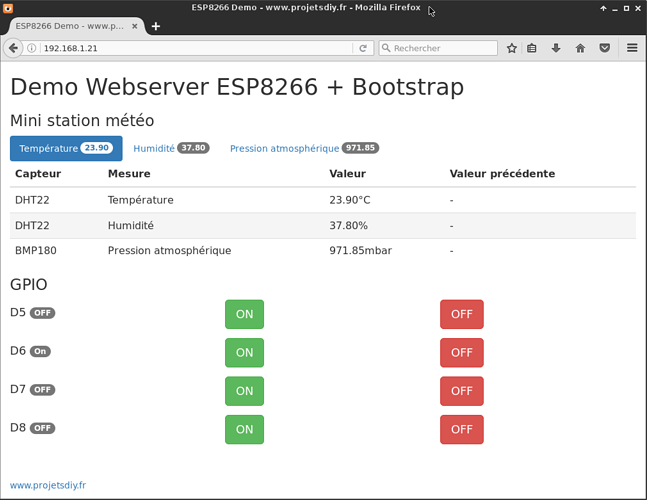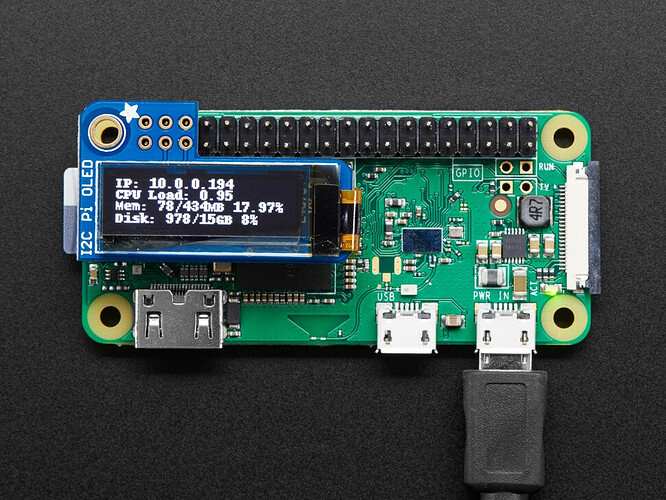I’m very new to Raspberry Pi. So far I’ve only been using it with Xojo built apps without any hardware interface.
I need to find a small display that can show a bit of text. I’m not thinking of a touch-screen or full color “monitor”, more like the LED displays from a calculator.
Anyone have any suggestions?
something like this :
lots of displays here too :
Wow, there are great options there.
I ordered a few of them. Now I’m sure I’ll break it all figuring out how to connect them and such
Thanks Jean-Yves.
well I’m not a big fan of raspberries… I prefer arduino and more specifically esp8266 or esp32
then I connect them on wifi or ethernet and connect them to xojo using tcpsocket.
a raspberry is really overkill to display small things or measure some temperature.
I’m not familiar with those other options.
I’m doing a lot more than just displaying messages though, so I do need a bit of processing muscle, and the PI seems appropriate.
Hello Jean-Yves,
I have now a Raspi 4B and a Arduino Uno.
With the Arduino Uno we now finished a project ( P5.JS, SerialControl , Uno for input…: ) but this was a prototype for VideoMapping and discovering P5…
As I saw your posting : I want to build a solution to control the watering of my garden
But I don’t have much sensors and valves.
Is Arduino a good choice to do it ?
I saw there are solutions for Raspi
Thanks and BR Rainer
an arduino will be more than enough for some valves and sensors.
for me, the raspberry is only needed if you need computing power, or a nice user interface with a touchscreen (and xojo indeed)
otherwise, an arduino, or better an esp8266 or esp32 will have more than enough power to commute some valves or read sensors. even be an html server with some displays.
look at this as an example of what is possible with an esp8266 !
Thats cool, thank you very much…
BR Rainer
Hi…there are two yield jacks for video on a Pi3A+. The principle one is HDMI. That should work with any showcase that has either a HDMI or DVI-D info. The other is a composite video yield that is joined with the simple sound yield in a 4-post 3.5mm jack.
Likewise - and the particular theme for this sub-gathering - is the RPF 7" touchscreen that associates through the DSI connector on the board. There are an assortment of outsider little shows, generally up to 3.5" that associate through the GPIO block, however for those you need to change the boot control documents,/boot/cmdline.txt and/boot/config.txt.
Hello Chris,
to have everything in a box for rapid prototyping I have spent some more money to purchase a joy pi case. It is small, hast a lcd touch screen and some more things ( have a look ).
HTH Rainer
With a bit of wiring you can hook up a 4 line LCD display.
https://documentation.xojo.com/topics/raspberry_pi/working_with_a_lcd_character_display.html
I just south, and had delivered, a tiny little 120x32 OLED for Rasperry pi from Adafruit.
I don’t even know where to begin with connecting it.
I also bought heat and humidity sensors, and I also don’t know how to start with these.
Someone should host a webinar. I’d pay to attend.
Can you tell what’s the part number ? I will then have a look.
They have a lot of displays at 128 x 32, but you talk about a 120 x 32 ?!?
Adafruit [3527 PiOLED - 128x32 Monochrome OLED Add-on for Raspberry Pi
https://www.amazon.com/gp/product/B07MM68H8M/ref=ppx_yo_dt_b_asin_title_o00_s00?ie=UTF8&psc=1
Get here Adafruit PiOLED - 128x32 Monochrome OLED Add-on for Raspberry Pi ID: 3527 - $14.95 : Adafruit Industries, Unique & fun DIY electronics and kits for a complete description of the product. Here is a picture from that page:
It shows the display installed on a Raspberry Pi Zero. As you can see it sits on the IO bus and the pc board has a hole so you can still use the mounting hole. These pin are for the i2c port. Further down the page there is a link to bring you to this page Overview | Adafruit PiOLED - 128x32 Mini OLED for Raspberry Pi | Adafruit Learning System. You will find interesting information.
Regarding the humidity and temperature sensors, tell me the part numbers and I will look at them.
I have a PI 4, I’m not sure I understand where to connect it there. There is a set of 4 pins off to the side, but the display has 9. I’m such a newbe at this!
This is the other sensors.
https://www.amazon.com/gp/product/B0795F19W6/ref=ppx_yo_dt_b_asin_title_o01_s00?ie=UTF8&psc=1
Gilles, you need to host an online class!
Well you could enquire on the Pi Forum.
With this sensor, it’s more complicated. The sensor itself is the white part soldered to a tiny PCB. You need to connect the + and - pins to +3.3V and GND respectively. The other pin is the input/output pin, and as far as I understand is bidirectional. It outputs data every 2 seconds.
Regarding software I found this Raspberry Pi Humidity Sensor using the DHT22 - Pi My Life Up but the code is for Python. PLEASE NOTE you don’t have to add a resistor as instructed, it’s already on the tiny PCB.
If you know someone that is fluent with Embedded Systems, he will help you with your project.
So it looks like I need a breadboard too.
To the best of your knowledge has anyone put together a Xojo friendly shopping list for someone beginning with raspberry pi?
that’s why I spent some more money for the joy pi case. It comes with a preconfigured os and all samples for the devices ( ok python,…).
If you know what u really want you can switch to a case with real wiring…
BR Rainer


